
Bumthang Valley is the main inhabited valley in the Bumthang district of Bhutan.

Bumthang Valley is the main inhabited valley in the Bumthang district of Bhutan.
Bumthang is one of the most beautiful and sacred valleys in Bhutan. [1]
The main town in the valley is Jakar. Bhutan's only brewery, brewing Red Panda wheat beer, is in Jakar.
Bumthang is divided into four gewogs , namely Chhoekhor, Tang, Chhume and Ura.
The valley is broad with various habitats including coniferous woodland.
The language spoken in Bumthang is known as Bumthang Kha, a Tibeto-Burman language. Each of the four valleys of Bumthang has its own dialect.

The Jampa Lhakhang temple is located in the heart of Jakar Vally, it was built in the early 7th century by the dharma king Songtsen Gempo.
He commissioned the creation of 108 temples at the same time to successive circles in order to pin down and evil demoness who was seen to be blocking the spread of Buddhism.
This monastery is one of two such temples that survive in Bhutan. the other being Kichu in Paro Dzongkhag. The Jampa Lhakhang is dedicated to Maitreya, the Buddha of the future.
Many historians assert the Buddhism appeared in the establishment of this Jampa Lhakhang. This temple remains as one of the most important landmarks of the country. The Jampa Lhakhang has never destroyed by fire, flood, wind or earthquake.
Guru Rinpochen used Jampa Lhakhang as a residence when he visited Bumthang. Even today there is still a small room above the entrance of the main temple that people believe was the very first seat of Guru Rinpochen.
The Jampa Lhakhang festival has become an increasing more popular tourist attraction due to two unique portions of the program in fire offering and Naked Dances. [2]

Pema Lingpa was born in Chel Baridrang in the Tang [Stang] valley in district of Bumthang. At the age of nine, the young Pema Lingpa began to apprentice as a blacksmith. It is said that he would often pretend to be seat on a throne, giving initiations and teachings, and performing ritual dance [cham]. Pema Lingpa was one of the five sovereign treasure of Guru Padmasambhava who hailed from Bumthang, Bhutanese people believed him to be a fully master who brought both cultural and spiritual reforms in Bhutan. He reveled numerous treasures such as scrolls, ritual objects, statues and so forth in accordance with the prophecy of Guru Padmasambhava for the benefit of all sentient beings. He was a great artist and a visionary lama who contributed to much positive changes with far reaching impact in Bhutanese history and culture. He was a preeminent Teron [discover of spiritual treasures] and is considered to be foremost of the five Treton Kings.in the history of the Nyingma school in Bhutan, Pema Lingpa is second in importance only to padmasambhava himself. He left several impressions of his feet on solid rocks in and around his birthplace, Chel Baridrang ,below the Kunzang drag temple. One of Pema Lingpa's most renowned treasure discoveries took place in Bhutan at Mebartso [burning lake], where before a large crowd he leaped into deep water with a Burning butter lam in his hand, later emerging with a term in one hand and the still burning butter lamp in the other. His works are popular and have flourished in each and every corner of the Himalayas. Many of these hand -made treasures are on display at the National Museum of Bhutan in Paro.
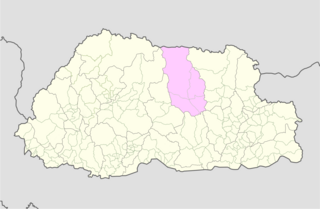

Ngawang Namgyal and known colloquially as The Bearded Lama, was a Tibetan Buddhist lama and the unifier of Bhutan as a nation-state. In addition to unifying the various warring fiefdoms for the first time in the 1630s, he also sought to create a distinct Bhutanese cultural identity separate from the Tibetan culture from which it was derived.
Articles related to Bhutan include:

Pema Lingpa or Padma Lingpa was a Bhutanese saint and siddha of the Nyingma school of Tibetan Buddhism. He is considered a terchen or "preeminent tertön" and is considered to be foremost of the "Five Tertön Kings". In the history of the Nyingma school in Bhutan, Pema Lingpa is second only in importance to Padmasambhava.

Paro is a town and seat of Paro District, in the Paro Valley of Bhutan. It is a historic town with many sacred sites and historical buildings scattered throughout the area. It is also home to Paro International Airport, Bhutan's sole international airport. Paro International Airport is served by Drukair.
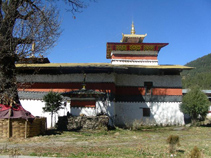
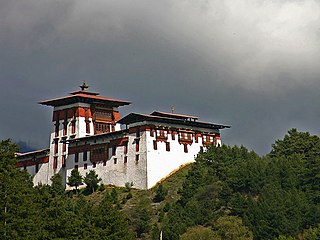
Jakar is a town in the central-eastern region of Bhutan. It is the district capital of Bumthang District and the location of Jakar Dzong, the regional dzong fortress. The name Jakar roughly translates as "white bird" in reference to its foundation myth, according to which a roosting white bird signalled the proper and auspicious location to found a monastery around 1549.
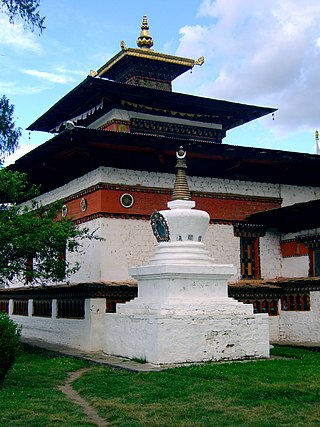
Kyichu Lhakhang, is an important Himalayan Buddhist temple situated in Lango Gewog of Paro District in Bhutan.

Rinpung Dzong, sometimes referred to as Paro Dzong, is a large dzong - Buddhist monastery and fortress - of the Drukpa Lineage of the Kagyu school in Paro District, Bhutan. It houses the district Monastic Body as well as government administrative offices of Paro Dzongkhag. It is listed as a tentative site in Bhutan's Tentative List for UNESCO inclusion.
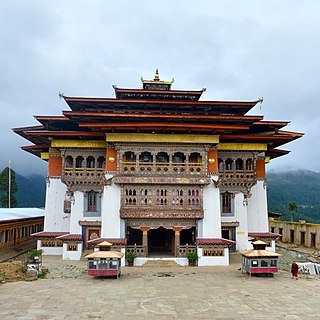
The Gangteng Monastery, generally known as Gangtey Gonpa or Gangtey Monastery, is an important monastery of Nyingmapa school of Buddhism, the main seat of the Pema Lingpa tradition. located in the Wangdue Phodrang District in central Bhutan. The Monastery, also known by the Gangten village that surrounds it, is in the Phobjikha Valley where winter visitors – the black-necked cranes – visit central Bhutan to roost, circling the monastery three times on arrival and repeating this circling when returning to Tibet. The Monastery's history traces to the early 17th century and back to the prophecies made by the well-known Terton Pema Lingpa in the late 15th century.

Paro Taktsang, is a sacred Vajrayana Himalayan Buddhist site located in the cliffside of the upper Paro valley in Bhutan. It is one of thirteen Tiger's Nest caves in historical Tibet in which Padmasambhava practiced and taught Vajrayana.
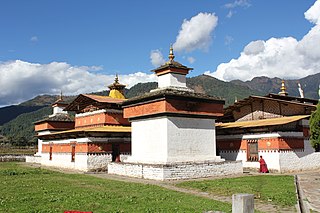
The Jampa Temple or Temple of Maitreya is located in Bumthang (Jakar) in Bhutan, and is said to be one of the 108 temples built by Tibetan King Songtsen Gampo in 659 CE on a single day, to pin down an ogress to earth forever.
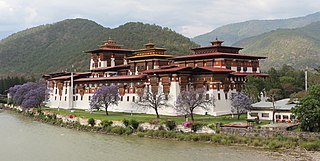
The Punakha Dzong, also known as Pungthang Dewa chhenbi Phodrang, is the administrative centre of Punakha District in Punakha, Bhutan. Constructed by Ngawang Namgyal, 1st Zhabdrung Rinpoche, in 1637–38, it is the second oldest and second-largest dzong in Bhutan and one of its most majestic structures. The dzong houses the sacred relics of the southern Drukpa Lineage of the Kagyu school of Tibetan Buddhism, including the Rangjung Kharsapani and the sacred remains of Ngawang Namgyal and the tertön Pema Lingpa.
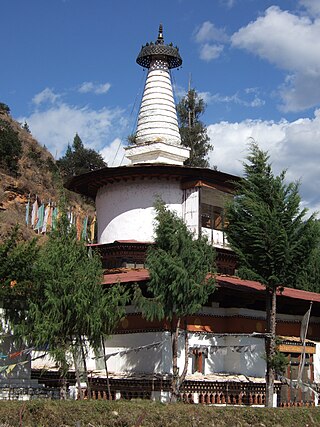
Jangtsa Dumgtseg Lhakhang[zlum brtshegs lha khang] is a Buddhist temple in western Bhutan. The temple is notable as it is in the form of a chorten, very rare in Bhutan. It is located on the edge of a hill between the Paro valley and the Dopchari valley, across the bridge from Paro. The Buddhist iconography depicted in the Chorten is considered a unique repository of the Drukpa Kagyu school.

Könchogsum Lhakhang, also known as Tsilung, is a Buddhist monastery in central Bhutan.
Ta Rimochan or Ti Rimochen is a Buddhist monastery in Bhutan belonging to the Nyingma school of Tibetan Buddhism.

Bumthang Province was one of the nine historical Provinces of Bhutan.
The Kingdom of Bumthang was one of several small kingdoms within the territory of modern Bhutan before the first consolidation under Zhabdrung Ngawang Namgyal in 1616. After initial consolidation, the Bumthang Kingdom became Bumthang Province, one of the nine Provinces of Bhutan. The region was roughly analogous to modern-day Bumthang District. It was again consolidated into the modern Kingdom of Bhutan in 1907.

The Yagang Lhakhang is a Buddhist temple, located in a village on the outskirts of Mongar in eastern Bhutan. It was built in the 16th century by Sangdag, the youngest son of Pema Lingpa, a famous tertön.
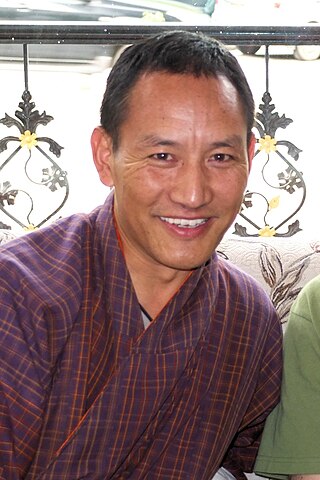
Lopen Karma Phuntsho is a former monk and Bhutanese scholar who specialises in Buddhism, Tibetan & Himalayan Studies and Bhutan, and has published a number of works including eight books, translations, book reviews and articles on Buddhism, Bhutan and Tibetan Studies. His The History of Bhutan has been called "the first book to offer a comprehensive history of Bhutan in English" and received Choice Outstanding Academic Title Award in 2015.